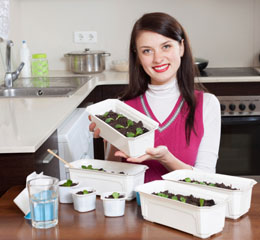Even if you live in a small house, it is possible to grow a vegetable garden, indoors, using container gardening. This article gives some information on growing a vegetable garden in containers, inside the house.

Having home-grown vegetables for lunch or dinner is a very satisfying experience. However, not everyone has the space to create a vegetable garden, especially city-dwellers who live in apartments. In such cases, vegetable container gardening is a very good option. Firstly, it lets you grow your own vegetables, and secondly, you can be sure that the vegetables you are eating are fresh and healthy. Doing this is actually quite easy, and if you choose the right vegetables and herbs to plant, along with the proper containers to plant them in, you can have a thriving vegetable garden, indoors.
When you decide to grow your own vegetables indoors, you should choose only those that thrive in small spaces and produce a good yield. You should also select the containers and decide where to place them, so that your vegetables grow better.
Choosing the Right Container
It is very important to choose a container that provides good drainage, and is big enough to support the weight of the plant. Containers made out of terracotta, plastic, or wood, work well for this type of gardening. However, you can be innovative and use old plastic bottles, plastic milk jugs, old, chipped teapots and sugar bowls, or empty cans, as containers. You can also use wooden boxes and crates, as well as empty barrels. Just make sure that these containers provide adequate drainage, otherwise there will be water logging and the plants will rot.
Choosing the Right Soil
After you have decided the containers that you will be using, it is time to select the soil. Any good-quality potting soil can be used. It should be fairly lightweight, with a good mixture of sand and soil that will allow easy drainage. Clay soil should not be used as it absorbs too much water, which results in the roots of the vegetables receiving very less air. Organic compost should be added to the soil mixture so that the plants receive adequate nutrients. Good-quality potting soil can be purchased from any gardening center or local nursery.
Choosing the Right Vegetables to Grow
Always select vegetables that thrive in small spaces. You can grow green salad leaves like lettuce, endive, spinach, and rocket leaves, or vegetables like baby carrots, cherry tomatoes, vine tomatoes, baby potatoes, chilies, and beans. These plants do not require too much sunlight, and hence grow well indoors. Many dwarf varieties of plants like gherkins, baby corns, and snow peas, are also great for growing in a container. Other vegetables that are easy to grow and thrive in containers are squash, eggplant, radishes, beetroot, peppers, and cucumbers.
Taking proper care of your vegetable garden is very important if you want healthy vegetables. Place the containers in a spot where they can get a little sunlight, like in a balcony or patio. Also, water and de-weed them regularly. Indoor vegetable gardening can be very rewarding and fun, and you can have home grown vegetables to eat.






 Having home-grown vegetables for lunch or dinner is a very satisfying experience. However, not everyone has the space to create a vegetable garden, especially city-dwellers who live in apartments. In such cases, vegetable container gardening is a very good option. Firstly, it lets you grow your own vegetables, and secondly, you can be sure that the vegetables you are eating are fresh and healthy. Doing this is actually quite easy, and if you choose the right vegetables and herbs to plant, along with the proper containers to plant them in, you can have a thriving vegetable garden, indoors.
Having home-grown vegetables for lunch or dinner is a very satisfying experience. However, not everyone has the space to create a vegetable garden, especially city-dwellers who live in apartments. In such cases, vegetable container gardening is a very good option. Firstly, it lets you grow your own vegetables, and secondly, you can be sure that the vegetables you are eating are fresh and healthy. Doing this is actually quite easy, and if you choose the right vegetables and herbs to plant, along with the proper containers to plant them in, you can have a thriving vegetable garden, indoors.